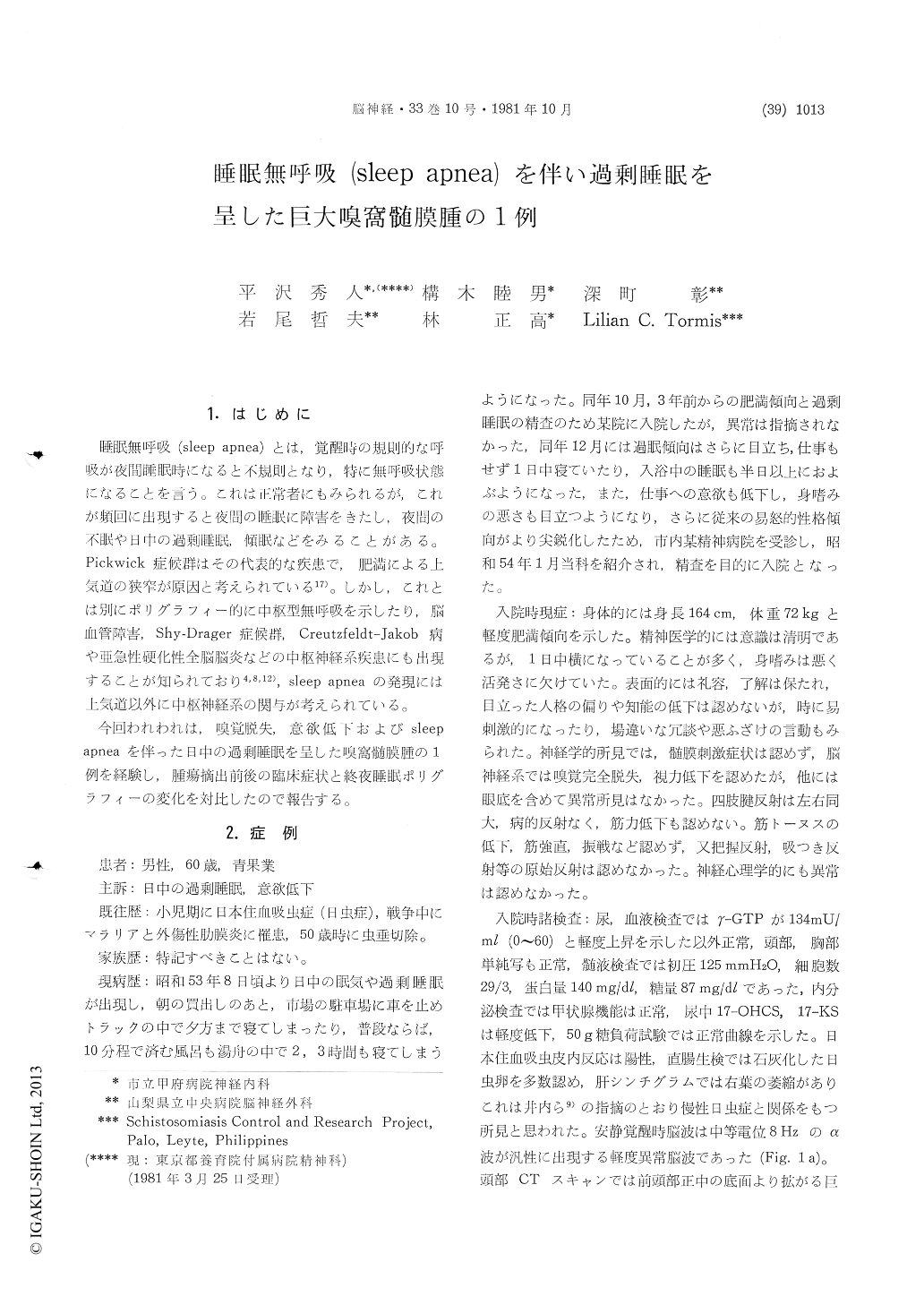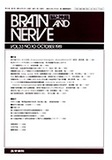Japanese
English
- 有料閲覧
- Abstract 文献概要
- 1ページ目 Look Inside
1.はじめに
睡眠無呼吸(sleep apnea)とは,覚醒時の規則的な呼吸が夜間睡眠時になると不規則となり,特に無呼吸状態になることを言う。これは正常者にもみられるが,これが頻回に出現すると夜間の睡眠に障害をきたし,夜間の不眠や日中の過剰唾眠,傾眠などをみることがある。Pickwick症候群はその代表的な疾患で,肥満による上気道の狭窄が原因と考えられている17)。しかし,これとは別にポリグラフィー的に中枢型無呼吸を示したり,脳血管障害,Shy-Drager症候群,Creutzfeldt-Jakob病や亜急性硬化性全脳脳炎などの中枢神経系疾患にも出現することが知られており4,8,12),sleep apneaの発現には上気道以外に中枢神経系の関与が考えられている。
今回われわれは,嗅覚脱失,意欲低下およびsleep apneaを伴った日中の過剰睡眠を呈した嗅窩髄膜腫の1例を経験し,腫瘍摘出前後の臨床症状と終夜睡眠ポリグラフィーの変化を対比したので報告する。
The patient is a 60-year-old male, who noted anosmia and excessive daytime sleepiness about 5 months prior to admission. Hypersomnia became progessively apparent one month before admission, in which the patient slept throughout the day without working and slept in the tub for more than 12 hours. He noticed a gradual loss of in-terest for work and inattention to his appearance. On admission to our hospital in January, 1979, the patient was slightly overweight (+16.4kgs. by Broca method). Psychiatrically, state of conscious-ness was clear, but was lacking in initiative, sometimes irritable and prone to making inap-propriate jokes. Except for bilateral anosmia and slight diminution of vision, there was no other neurologic deficit. CSF showed normal pressure with slight elevation in cell count, protein and glucose content. Hormonal exam. revealed a slight decrease in 17-KS and 17-OHCS. Skull and chest x-rays were normal. Results of the carotid angio-graphy and CT-scan disclosed a large olfactory groove meningioma about 7cm. in diameter.
The clinical symptoms of anosmia, slight diminu-tion of vision and hypersomnia markedly improved after extirpation of the tumor recovered in the anterior cranial fossa. During the convalescence period, the patient had severe diarrhea of undeter-mined etiology, but didn't lose weight.
An all night polygraphic recording was obtained by conventional methods, before and after opera-tion, with time duration of 11 and 10 hours for each, respectively. During the preoperative poly-graphic recording, apnea appeared 255 times during the 11 hours' recording, each lasting for 10-20 seconds. After operation, apnea occurred 250 times during the 10 hours' recording, with almost same duration. The percentage of time spent in apnea was significantly increased during stage II and REM. The patient exhibited both central and ob-structive types of apnea. It is interesting to note that prior to surgery, apnea which was recurrent throughout most of the night, disrupted stages II and REM, thereby causing a shift to stages I or W. Stages III or IV were absent with marked decrease in REM (2.8%). After surgery, although apnea persisted, stage II progressed to stages III-IV with subsequent increase in the latter stages (10.1%) including REM (13.9%).
This is a typical neuro-psychiatric of olfactory groove meningioma which caught our interest be-cause of the chief complaint of hypersomnia. In the present case, there was no disturbance of consciousness, and clinically, it seemed that there is no direct influence on the lower brain stem and mesencephalon as shown by the results of the laboratory procedures and clinical symptoms. At first glance, this resembles the Pickwickian syn-drome wherein the progression into deeper sleep stage in interrupted by sleep apnea through ob-structive causes. However, we have observed that in this case, the sleep apnea persisted even after surgery, and in addition, there was almost the same number or appearance rate of apnea as in the preoperative recording, hence, causative factors of hypersomnia must be searched from other sources. It is therefore suffice to say that the peripheral obstruction is greatly related to the central respi-ratory system. With the surgical removal of the tumor, subsequent recovery from dysfunction of the sleep center occurred, which resulted in the disappearance of a block in deep sleep and REM stage. Considering these observations, it cannot be denied that the influence on the sleep circadian rhythm is exerted on the central sleep centers such as the hypothalamus, pineal gland, etc.

Copyright © 1981, Igaku-Shoin Ltd. All rights reserved.


